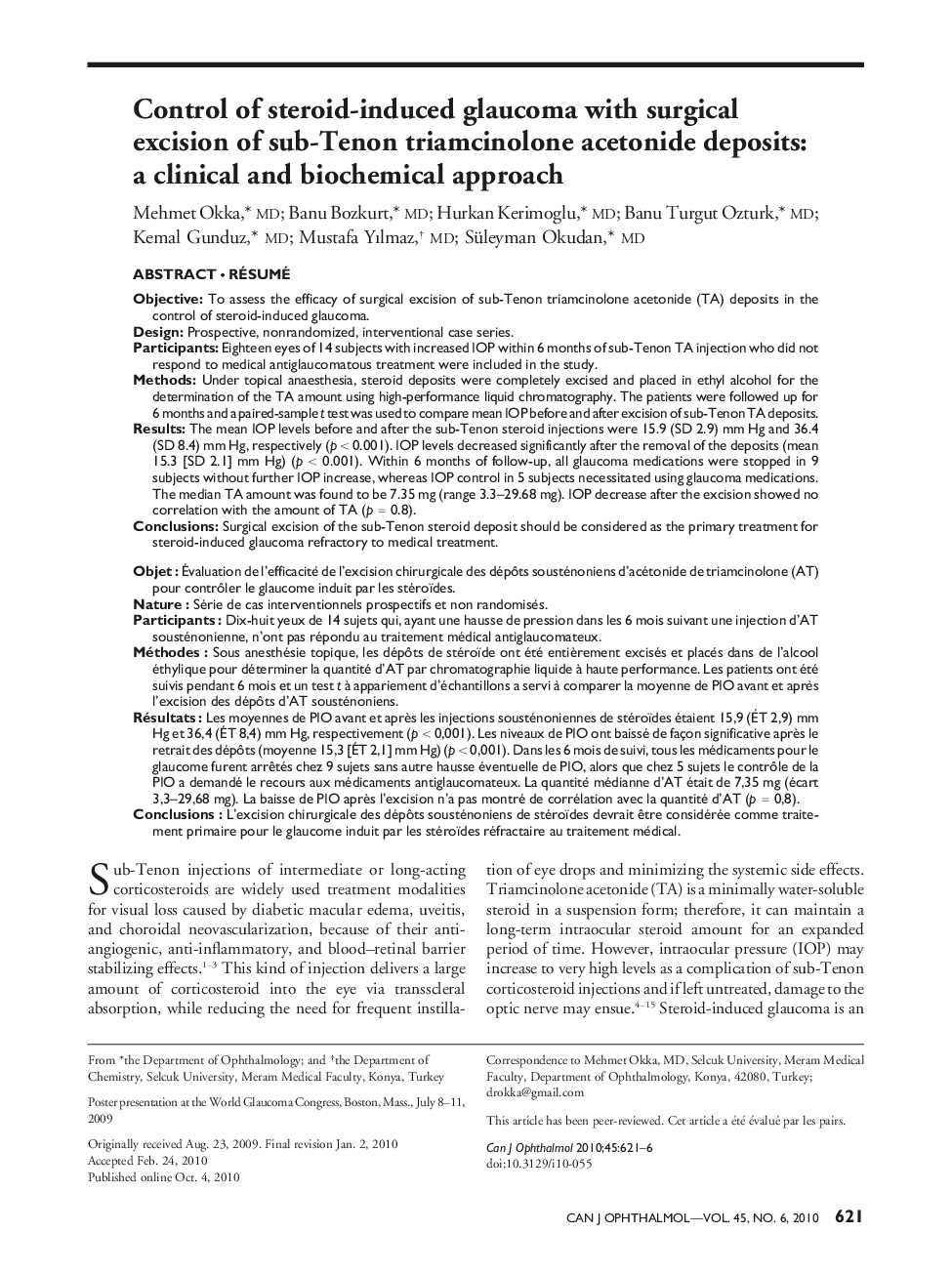| کد مقاله | کد نشریه | سال انتشار | مقاله انگلیسی | نسخه تمام متن |
|---|---|---|---|---|
| 4010127 | 1602426 | 2010 | 6 صفحه PDF | دانلود رایگان |

Objective: To assess the efficacy of surgical excision of sub-Tenon triamcinolone acetonide (TA) deposits in the control of steroid-induced glaucoma.Design: Prospective, nonrandomized, interventional case series.Participants: Eighteen eyes of 14 subjects with increased IOP within 6 months of sub-Tenon TA injection who did not respond to medical antiglaucomatous treatment were included in the study.Methods: Under topical anaesthesia, steroid deposits were completely excised and placed in ethyl alcohol for the determination of the TA amount using high-performance liquid chromatography. The patients were followed up for 6 months and a paired-sample t test was used to compare mean IOP before and after excision of sub-Tenon TA deposits.Results: The mean IOP levels before and after the sub-Tenon steroid injections were 15.9 (SD 2.9) mm Hg and 36.4 (SD 8.4) mm Hg, respectively (p < 0.001). IOP levels decreased significantly after the removal of the deposits (mean 15.3 [SD 2.1] mm Hg) (p < 0.001). Within 6 months of follow-up, all glaucoma medications were stopped in 9 subjects without further IOP increase, whereas IOP control in 5 subjects necessitated using glaucoma medications. The median TA amount was found to be 7.35 mg (range 3.3–29.68 mg). IOP decrease after the excision showed no correlation with the amount of TA (p = 0.8).Conclusions: Surgical excision of the sub-Tenon steroid deposit should be considered as the primary treatment for steroid-induced glaucoma refractory to medical treatment.
Objet: Évaluation de l’efficacité de l’excision chirurgicale des dépôts sousténoniens d’acétonide de triamcinolone (AT) pour contrôler le glaucome induit par les stéroïdes.Nature: Série de cas interventionnels prospectifs et non randomisés.Participants: Dix-huit yeux de 14 sujets qui, ayant une hausse de pression dans les 6 mois suivant une injection d’AT sousténonienne, n'ont pas répondu au traitement médical antiglaucomateux.Méthodes: Sous anesthésie topique, les dépôts de stéroïde ont été entièrement excisés et placés dans de l’alcool éthylique pour déterminer la quantité d’AT par chromatographie liquide à haute performance. Les patients ont été suivis pendant 6 mois et un test t à appariement d’échantillons a servi à comparer la moyenne de PIO avant et après l’excision des dépôts d’AT sousténoniens.Résultats: Les moyennes de PIO avant et après les injections sousténoniennes de stéroïdes étaient 15,9 (ÉT 2,9) mm Hg et 36,4 (ÉT 8,4) mm Hg, respectivement (p < 0,001). Les niveaux de PIO ont baissé de façon significative après le retrait des dépôts (moyenne 15,3 [ÉT 2,1] mm Hg) (p < 0,001). Dans les 6 mois de suivi, tous les médicaments pour le glaucome furent arrêtés chez 9 sujets sans autre hausse éventuelle de PIO, alors que chez 5 sujets le contrôle de la PIO a demandé le recours aux médicaments antiglaucomateux. La quantité médianne d’AT était de 7,35 mg (écart 3,3–29,68 mg). La baisse de PIO après l’excision n'a pas montré de corrélation avec la quantité d’AT (p = 0,8).Conclusions: L’excision chirurgicale des dépôts sousténoniens de stéroïdes devrait être considérée comme traitement primaire pour le glaucome induit par les stéroïdes réfractaire au traitement médical.
Journal: Canadian Journal of Ophthalmology / Journal Canadien d'Ophtalmologie - Volume 45, Issue 6, December 2010, Pages 621-626